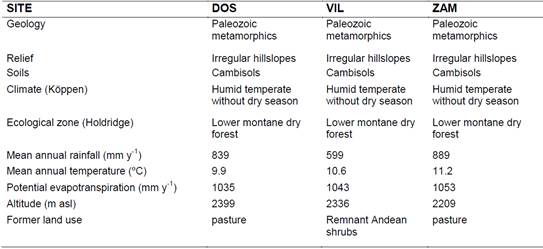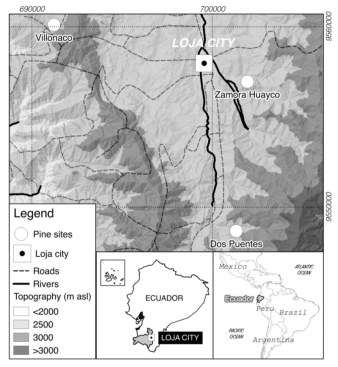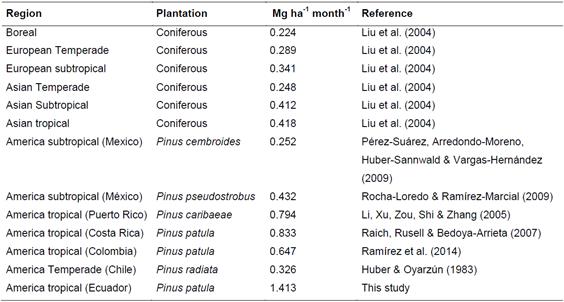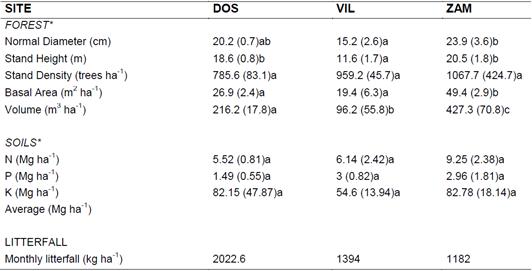1. Introduction
Among various biogeochemical processes that occur in forest environments, the formation of organic matter and its subsequent decomposition are of upmost importance, being the last one the more attractive to study in our days (Berg & Laskowski, 2005; Osman, 2013; Berg, 2014; Berg, Kjønaas, Johansson, Erhagen, & Åkerblom, 2015). Decomposition begins with the accumulation of plant material on the ground, this material, known broadly as litterfall, includes dominantly leaves, stems, branches, bark, flowers and fruits that are continuously stripped of the vegetation (Osman, 2013; Berg et al., 2015). Therefore, litterfall is the primary source of organic matter for soils under forest environments (Berg & Laskowski, 2005; Berg & McClaugherty, 2014). The presence of litterfall influences over some micro-environmental and physical soil conditions such as soil temperature, light interception, and water dynamics (Facelli & Pickett, 1991). Litterfall is also related to chemical processes involved in the transfer of nutrients and energy from vegetation to the soils, becoming a key link in biogeochemical cycles (Liu et al., 2004; Paudel, Dossa, Xu, & Harrison, 2015). The study of litterfall production under several types of forests has been a topic widely discussed in different latitudes of our planet (Chave et al., 2010; Berg & McClaugherty, 2014); however, for the Andes region its study is scarce, and particularly for exotic pine plantations in this region is even more.
Although, Pinus is one of the most significant tree genus around the world from the social and economic point of view (Richardson, 2000), little is know about the litterfall production in the Andes; only a couple of studies have been reported for this region, one developed in Colombia (Ramírez et al., 2014) and another in Chile (Huber & Oyarzún, 1983). This highlights the importance of this study for the Andes where there are large areas reforested with the introduction of pine species along South America (Simberloff et al., 2010). This reality is not an exception for Ecuador where programs of reforestation and afforestation with pine have been established in the Andean region since the second half of the twentieth century (Mejía & Pacheco, 2013; Knoke et al., 2014). However, the common denominator was that most plantations have been established without any previous study (van Voss, Aguirre, & Hofstede, 2001). As a result, recent studies reported more disadvantages than benefits due to the pine establishment in this region (Leischner & Bussmann, 2003; Buytaert, Iñiguez, & Bièvre, 2007; Chacón, Gagnon, & Paré, 2009; Crespo et al., 2010; Quichimbo et al., 2012). Therefore, the study of litter production would help to better understanding of cycling of materials in forest environments, which in turn would result in a contribution to better forest resources management in the region.
Within this context, initiatives like the DFG Transfer project: "New Forest for Ecuador" (Mosandl & Günter, 2008; Günter, Calvas, Lotz, Bendix, & Mosandl, 2013;) whose goal is the conservation and sustainable management of forest resources in Ecuador through a new model of forestry based on establishment of mixed forests (Ashton, 2014) taking into account plantations of exotic tree species as an intermediate step towards the transition to native forests (Weber, Stimm, & Mosandl, 2011). Consequently, in the framework of that project, pine plantations are one of the forest resources under study and the dynamics of pine litterfall production is one of the central themes. This research aims to i) estimate the monthly pine litterfall production for the study area, and ii) assess the temporal dynamics of litterfall production at sites of pine plantations in the southern Andes Ecuador.
2. Methods
2.1. Study area
This research was carried out in the province of Loja at southern Andean region of Ecuador. Three sites of pine plantations (Pinus patula) known as Dos Puentes (DOS), Villonaco (VIL), and Zamora-Huayco (ZAM) were selected (Figure 1). These plantations are older than 15 years and they are located on the western side of the Andes Mountain Range. Environmental variables for the sites are described in Table 1.
2.2. Sampling design
One monitoring square plot of 144 m2 was implemented in each pine (Pinus patula) site. On each square plot, 16 litterfall traps were located. Each trap had a capture area of 900 cm2 and they were installed in a systematic arrangement (Figure 2). The sampling frequency was 15 days (+/- 24 hours) to collect the litterfall material, and the total collection period was five months, from June to October 2014.
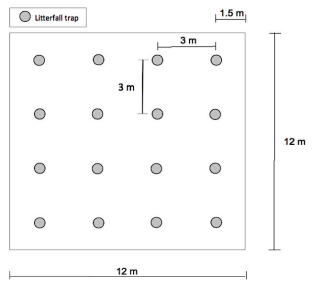
Fig. 2: Design for litterfall trap distribution within the litterfall plots (systematic arrangement).
Additionally, forest structural characteristics: Normal diameter (diameter at breast height), stand height, stand density, basal area, and stand volume, were considered together with soil nutrient stocks (macronutrients: N, P, and K). All these data were taken from Quichimbo et al. (2014b).
2.3. Laboratory analysis
After field sampling, each litterfall sample was weighed and then dried at 40°C, using a forced air circulation oven (MEMMERT UFE600, Germany) until reach constant weight (approximately 48 hours).
The monthly litterfall biomass production was computed in kilograms of dry matter per hectare, and the following equation was used (Berg & Laskowski, 2005):

Where:
DM: Monthly dry matter biomass per area (kg ha-1 m-1)
m1: container weight plus dried sample (40 ºC).
m0: empty container weight (kg).
a: trap capture area (0.09 m2)
b: transformation factor to get values in kg ha-1 (10)
Furthermore, to estimate the macronutrients stocks for pine species: N, P, and K, we have used data of nutrient contents of pine (Pinus patula) plantations located also in the south of Ecuador (Province of Loja), from Quichimbo et al. (2016, in preparation), where the micro-Kjeldahl method was used to determined the nitrogen content (Kjeltec 2200 auto distillation, Sweden); phosphorus and potassium concentrations were determined by acid digestion and subsequent ICP-OES (Perkin Elmer Optima 5300 DV, USA) measurements.
2.4. Statistical analyses
Biomass determination corresponds to the dry weight of the litter samples (dried at 40°C) and computed as the average amount collected by traps per event and expressed in kg ha-1 for accumulated values per month. Since the data did not meet assumptions of normal distribution (Shapiro-Wilk test, P-value = 0.05), all data were described by median values and absolute deviations of the medians. Comparisons between sites and between months were evaluated by the nonparametric Kruskal-Wallis test at 5% level of significance. A Post-Hoc Benjamini Hochberg procedure after Kruskal-Wallis test was applied. Statistical analyses were performed using the R software version 3.2.3 (R Development Core Team, 2016).
3. Results and discussion
3.1. Biomass production estimation
Monthly litterfall dry matter production for the study area (on the basis of the five months period) ranges from 1067 to 1907 kg ha-1 (Figure 3a). Although, differences in litterfall production could be attributed to several environmental factors (Berg & McClaugherty, 2014), at global scale climatic factors (temperature and precipitation) are controlling the litterfall production (Liu et al., 2004), and based on this assumption and also due to the scarcity of data for pine litterfall production in the tropics (especially in tropics of America), we have developed our analysis. The presented values of litterfall in this study are higher compared with information reported in conifers studies from other regions of the world (Table 2). Additionally, based on a regional analysis within America, it can be seen that the tropical zone shows a higher monthly litter production, highlighting the Andean region of Colombia and Ecuador that presents the highest values (Table 2). The nutrient content pattern for the litterfall was: N>K>P (7.14%, 2.34%, 0.95%, respectively), this trend is consistent with the reported by Ramirez et al. (2014) in pine plantations located in montane Andean forest region in Colombia. However, the study of nutrient stocks in litterfall is not the main focus of this present work, but it is studying in an ongoing investigation, which is developed by Quichimbo et al. (2016, in preparation).
On the other hand, this research revealed the highest monthly values of litterfall production (average mean value: 1413 kg ha-1) for the American tropical region, but it must be taken into account that this value reflects an average estimation based on a fraction of the year (from June to October) and the litter production may also present temporal variations over the year (Osman, 2013). Under this context, this high value probably coincided with a period of high production into the year. Therefore, it is necessary to address further research to assess the litterfall production based on a larger period like one year, in this regard Proctor (1983) stated that an evaluation of data along one year could be enough to bring representative information for this goal. Nevertheless, the reported data in this study give us an overview of the large production of litterfall that is generated in the Ecuadorian Andean region under pine plantations.
Regarding with the variability of litterfall production among pine plantation sites (DOS, ZAM, VIL), the largest value of monthly litterfall production was reported by DOS (1907 kg ha-1 month-1). However, no statistically significant differences were found among them (Kruskal-Wallis, P>0.05). Also, statistical differences on soil nutrient stocks were not detected (Table 3), meaning that under the site conditions of this study, soils is not influencing the litterfall production. On the other hand, the effect of forest structural attributes was only present in the stand density (Table 3). Thus, there is an increasing litterfall production with decreasing density, this type of trend is not expected because studies of thinning (a type of reduction of stand density) effects, like the recent work of Jiménez & Navarro (2016) in pine plantations of similar age to this study, have reported an increased amount of litterfall with the increase of stand density. Our findings suggest that the litterfall production in the study area could be affected by other factors than forest structure and soils; probably it will be the climate due to the effect of dryness as explained in the section of the dynamic of litterfall.
3.2. Assessment of the dynamics of litterfall production
Litterfall production within each site showed statistical differences between months (P<0.05 for each site). However, between sites, monthly litter production showed similar patterns (Figure 3b). The highest production among sites was presented in August; in this regard, the lack of precipitation can be affecting the production of litterfall and as indicated by Liu et al. (2004) since the litterfall production of pine correlates with dryness conditions. Therefore the amount of litterfall material in the months of monitoring shows a clear trend towards an increased production in the dry period, this coincides with the dryness in August, considered as one of the driest months of the year in the study area, based on an average of the annual precipitation computed on the basis of a 40-year period (1965-2005) (PNUMA, Ilustre Municipio de Loja, & Naturaleza y Cultura Internacional, 2007). On the other hand, according to Berg & Laskowski (2005) and Osman (2013) dryness (dry seasons) is correlated with the increased litterfall production, thus for example in northern latitudes, this can influence on amount of litterfall material produced under conifer plantations, showing a deviation from the normal pattern that usually occurs in Autumn. But, in tropical areas with the absence of seasons, this dryness seems to be an important factor that triggers an increased production of litterfall (León, González, & Gallardo, 2010; Ramírez et al., 2014).
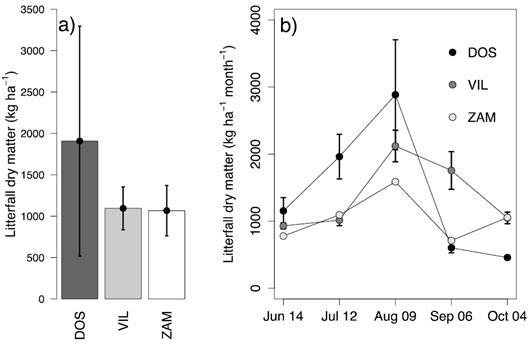
Fig. 3: Litterfall dry matter production: a) Monthly dry matter production of litterfall between sites: median values and median absolute deviation errors. No significant differences were observed between sites (Kruskal-Wallis test, P=0.05, p-value = 0.29). b) Monthly dry matter production of litterfall (median values and median absolute deviation) for the different sites.
4. Conclusions
Litterfall production in pine plantations (Pinus patula) turned out to be high for the southern Andean region of Ecuador in relation to other regions of America and other continents. It can also be noted that litter production is not uniform for the analyzed period, existing a month of maximum litterfall production, this production is related to conditions of low rainfall under the period and area of study. However, future work should address the need to analyze litterfall production throughout the year to understand the production patterns to support the findings of this study.













